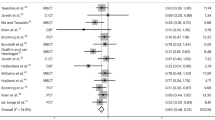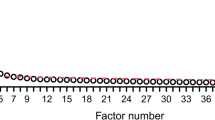Abstract
It remains difficult to determine in what measure improvements observed in clinical trials of antidepressants may be attributable to the psychological predispositions of the subjects. The present article focuses on the effect of a psychological variable, the Health Locus of Control, which measures the extent of a subject's belief that he is in control over his own health. The hypothesis is that depressed subjects whose locus of control is internal, i.e. who perceive themselves to be in control, rather than external, i.e. control perceived as being in others or just chance, will improve more markedly and consistently on the Hamilton Depression Rating Scale, across a number of clinical trials. Forty-nine depressive patients undergoing treatment with four different compounds were included, after a week's placebo run-in period, in a classical 42-day follow-up study comprising visits on days −7, 0, 10, 21; and 42. Interactions between the type of locus of control and the clinical course were investigated by MANOVA. Results show that with a classical design of clinical trials of antidepressants, locus of control plays a significant role if it is internal (P<0.001) in consolidating the improvement process, and that this is true irrespective of type of antidepressant. The relationship between the concept of locus of control and placebo effect is discussed.
Similar content being viewed by others
References
Abramson LY, Seligman MEP, Teasdale JD (1978) Learned helplessness in humans: critique and reformulation. J Abnorma Psychol 87:49–74
Abramson LY, Metalsky GI, Alloy LB (1989) Hopelessness depression: a theory-based subtype of depression. Psychol Rev 96:358–372
APA (1987) Diagnostic and statistical manual of mental disorders, 3rd edn, revised (DSM-III-R). The American Psychiatric Association, Washington, DC
Bech P, Malt UF, Dencker SJ, Ahlfors UG, Elgen K, Lewander T, Lundell A, Simpson GM and Lingjaerde O (1993) Scales for assessment of diagnosis and severity of mental disorders. Act Psychiatr Scand 372:3–87
Benassi VA, Sweeney PD, Dufour CL (1988) Is there a relationship between locus of control orientation and depression? J Abnorm Psychol 97:357–367
Castrogiovanni P, Maremmani I, Deltito JA (1989) Discordance of self-ratings versus observer ratings in the improvement of depression: role of locus of control and aggressive behaviour. Comp Psychiatry 30:231–235
Endlich E (1989) Depression and attributions for problems and solutions in college students. Psychol Rep 65:131–41
Hamilton M (1960) A rating scale for depression. J Neurol Neurosurg Psychiatry 23:56–61
Harrow M, Ferrante A (1969) Locus of control in psychiatric patients. Arch Gen Psychiatry 33:582–589
Hoojer C, Zitman FG, Griez E, Van Tilburg W, Willemse A, Dinkgreve M, Att M (1991) The Hamilton depression rating scale (HDRS): changes in scores as a function of training and version used. J Affect Disord 22:21–29
Kobasa SC, Maddi SR, Kahn S (1982) Hardiness and health: a prospective study. J Person Soc Psychol 42:168–77
Lau RR (1988) Beliefs about control and health behaviour. In: Gochman D (ed.) Health behaviour: Emerging research perspectives. Plenum, New York
Lau RR and Ware JE (1979) Refinements in the measurement of health-specific locus of control beliefs. Med Care 19:1147–1158
O'Brien KP, Glaudin V (1988) Factorial structure and factor reliability of the Hamilton rating scale for depression. Acta Psychiatr Scand 78:113–120
Reichlin S (1993) Neuroendocrine-immune interactions. N Engl J Med 329:1246–1253
Reynaert C, Parent M, Mirel J, Janne P, Haazen L (1995) Moclobemide versus fluoxetine for a major depressive episode. Psychopharmacology (in press)
Rotter JB (1966) Generalized expectancies for internal versus external of reinforcment. Psychol Monogr 80:1–28
Seligman MEP (1975) Helplessness: on depression, development, and death. Freeman, San Francisco
Stassen -HH; Delini-Stula -A; Angst -J (1993) Time course of improvement under antidepressant treatment: a survival-analytical approach. Eur-Neuropsychopharmacol 3:127–35
Statistical Package for Social Sciences (1986) Library of Congress Cataloging-in-Publication Data Norusis M.J. (Marija J) 1948-SPSS/PC + SPSS Inc. Chicago
Wallston BS, Wallston KA (1978) Locus of control and health: a review of the literature. Health Educ Monogr 6:107–177
Wallston KA, Wallston BS, De Vellis R (1978) Development of the multidimensional health locus of control (MHLC) scale. Health Educ Monogr 6:160–170
Wallston KA, Wallston BS, Smith S, Dobbins CJ (1987) Perceived control and health. Curr Psychol Res Rev 6[1]:5–25
Author information
Authors and Affiliations
Rights and permissions
About this article
Cite this article
Reynaert, C., Janne, P., Vause, M. et al. Clinical trials of antidepressants: the hidden face: where locus of control appears to play a key role in depression outcome. Psychopharmacology 119, 449–454 (1995). https://doi.org/10.1007/BF02245861
Received:
Revised:
Issue Date:
DOI: https://doi.org/10.1007/BF02245861




